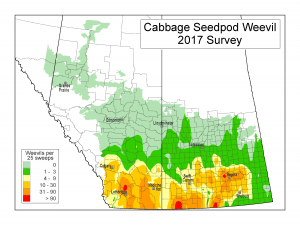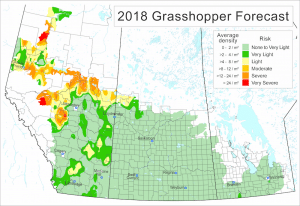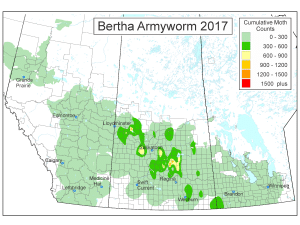The Prairie Pest Monitoring Network (PPMN) is a collaborative project involving federal entomologists from Agriculture and Agri-Food Canada, provincial entomologists from Alberta Agriculture and Forestry, Manitoba Agriculture, and the Saskatchewan Ministry of Agriculture, and entomologists from academic institutions. PPMN coordinates prairie-wide surveys for key agricultural pests including bertha armyworm, grasshoppers, cabbage seedpod weevil, pea leaf weevil and wheat midge. Information collected during the surveys is communicated during the growing season via the PPMN Weekly Update (subscribe to the Weekly Update by visiting the PPMN blog) and annually using regional pest distribution and forecast maps.
Regional maps for insect pests affecting canola are provided below:
Cabbage seedpod weevil. The 2017 map shows the distribution and population density of the cabbage seedpod weevil based on sweep net samples collected after plants have started to bud. CSPW scouting and spray timing.

(Click maps to enlarge.)
Grasshoppers. The map below illustrates the 2018 grasshopper forecast, which is based on population densities of reproductive adults and abiotic conditions recorded in 2017. Actual grasshopper densities observed in 2018 may differ from the forecast due to variations in climatic conditions.
Bertha armyworm. The bertha armyworm map is based on the number of male moths caught in pheromone traps. During the growing season, the Weekly Update provides near-real time bertha armyworm information to guide scouting and monitoring activities by agronomists and producers. Monitoring protocols and economic threshold information for key agricultural pests on the prairies are also available on the PPMN blog.
Current funding support (2015-2019) for PPMN is led by Western Grains Research Foundation who is partnered with the Saskatchewan Canola Development Commission, Manitoba Canola Growers, Alberta Wheat Commission, Saskatchewan Pulse Growers, Saskatchewan Flax Development Commission and Agriculture and Agri-Food Canada.
Further reading:
Thresholds for major canola insects



